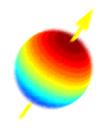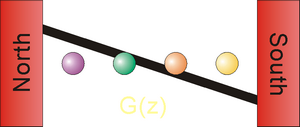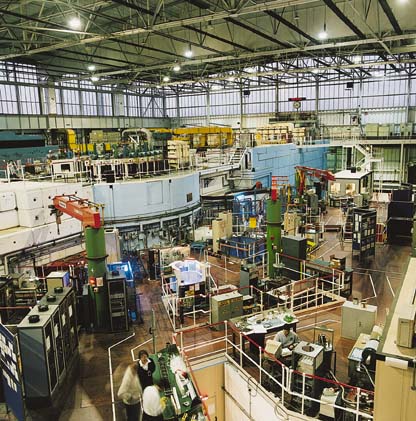Techniques
NMR | SANS

NMR: Nuclear Magnetic Resonance
The NMR techniques used in this group include:
- Solvent Relaxation NMR
- Pulsed-field gradient NMR
- Solid State NMR
Pulsed-field gradient NMR
Nuclear magentic resonance (NMR) is a widely used technique for probing the structure of molecules. It is a non-invasive technique, which means that information can be obtained about the molecules without altering their properties.
While NMR is a useful technique for probing the structure of molecules, it can also provide information about the translational diffusion of the molecule under investigation. This technique is usually referred to as pulsed-field gradient NMR (PFG-NMR). The technique uses a pulse sequence containing both radiofrequency and magnetic field gradient pulses. By applying a magnetic field gradient, the spins will feel a different magnetic field, depending on their position in the sample:

In other words, the magnetic field gradient labels the spins in the molecule with position-dependent phase angles, making them sensitive to diffusion. The attenuation of the echo signal from the pulse sequence is used to measure the displacement of the observed spins.
PFG-NMR is a powerful tool, since it can measure molecular diffusion down to values of 10-17 m2 s-1. It can be used to follow the diffusional behaviour of the individual components in a multi-component system. It can also be used to study restricted diffusion, for example in emulsion systems, where the internal radius of the emulsion droplet may be determined.
Hopefully full explanations of the other techniques will follow. In the meantime try this page for a comprehensive explanation of NMR theory:
http://www.cis.rit.edu/htbooks/nmr/nmr-main.htm
SANS: Small-angle neutron scattering
Small-angle neutron scattering, also commonly referred to by the acronym SANS, is widely used by our group. What folllows is a brief introduction to the technique.
SANS involves the firing of neutrons, neutral sub-atomic particles, at a sample and measuring the angle through which they are scattered.
It is not, however the angle of scatter itself that is of paramount importance to the experimentalist, but a quantity known as Q, called the momentum transfer. Q is simply the angle of scatter corrected for the wavelength of the incident neutron beam. Q is given by:
SANS data is therefore often plotted as scattered intensity vs. Q.
Neutron scattering is a valuable research tool as it allows the microscopic structure of colloidal, polymer and surfactant systems to be studied. It provides information on the shape and size of the small-scale structures often found within such systems.
For example, surfactants at high concentrations form self-assembled structures. The most common of which is the simple micelle. The scattering from a micellar solution has a characteristic maximum. The size and position of the peak (when fitted with an appropriate equation) gives information on the size, shape and charge at the surface of the micelle as well as the number of monomers in the micelle.
There are many other varied applications of the technique:
- Scattering from polymer solutions
- Scattering from adsorbed polymers
- Scattering from particles
A more detailed description of neutron scattering theory can be found on the ISIS website:
http://www.isis.rl.ac.uk/largescale/loq/documents/sans.htm
The following small-angle scattering instruments have been used by this research group:
- LOQ, ISIS, Didcot, UK
- D11, ILL, Grenoble, France
- D22, ILL, Grenoble, France
- V4, BENSC, Berlin, Germany
- SANS-1, GKSS, Geestacht, Hamburg, Germany
- KWS-1, FZ Jülich, Jülich, Germany
- KWS-2, FZ Jülich, Jülich, Germany
- SANS-1, SINQ, PSI, Switzerland
- SANS-2, SINQ, PSI, Switzerland
- NG-3, N.I.S.T., Washington D.C., U.S.A.
Beamtime is available by application - information on how to apply is provided by the appropriate websites from our links page: Neutron Facilities Links